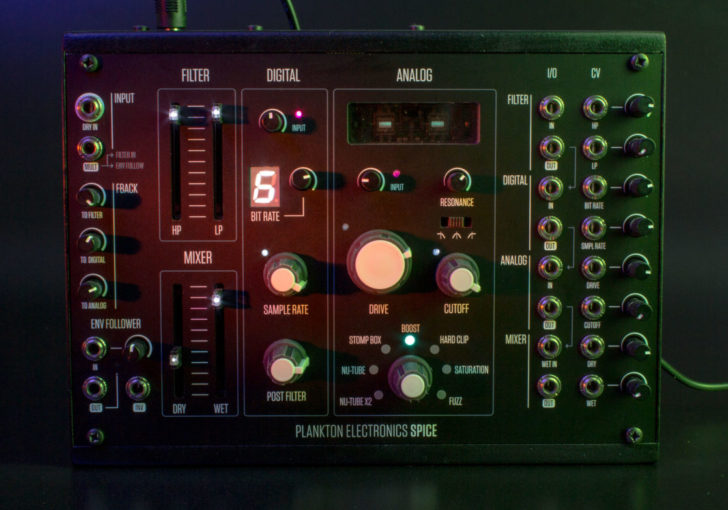
Plankton Electronics has introduced SPICE, a modular distortion unit that can be used as a desktop unit or in a Eurorack system.
The core of SPICE is the Analog section with 7 different analog circuits, each one offering a different color and harmonics to your sound:
- BOOST: A clean circuit. It is used when you want to use the filter without any distortion.
- SATURATION: A soft clip saturator. It adds a bit of harmonics to warm up your signals.
- HARD CLIP: A classic circuit that distorts the signal in a stronger way.
- NU-TUBE: A tube distortion from the Korg Nu-tube vacuum fluorescent display.
- NU-TUBE X2: Both channels of the Nu-tube for a higher gain tube distortion.
- FUZZ: A transistor based fuzz circuit for strongly clipped effects.
- STOMP BOX: a filtered high gain distortion based on some popular guitar pedals.
Here’s the official video intro:
Features:
- Rackable (34HP eurorack) modular desktop unit.
- 8 CV inputs with led level indicators.
- 6 main functions: Prefilter / Digital / Analog / Mixer / Envelope Follower / Feedback
- Prefilter: High Pass and Low Pass filters to shape the sound before being processed. Both controllable via fader + CV input.
- Digital: 12 bit Bit Crusher + Sample Rate reducer. Both controllable via potentiometer and CV inputs. It also offer an analog input control with led clip indicator and a low pass filter to smooth the output signal.
- Analog: 7 analog distortion circuits selectable with a rotary encoder + a sweet resonant state variable filter. Drive and Cutoff parameters are controllable via potentiometer and CV inputs. 2 of the circuits use the new Korg NU-TUBE.
- Mixer: Dry and Wet controls to mixed the processed signal with the clean one of the input. Both controllable via fader + CV input.
- Envelope Follower: A dedicated envelope follower with gain control and normal and inverted outputs to convert an incoming signal to an envelope. With its output you can control any of the CV parameters and shape the processed sound in many creative ways.
- Feedback: a triple feedback section that sends the Wet input to the Prefilter, Digital and Analog sections. It’s capable from a subtle resonance to a collapsed hardcore self generating tone.
- Semi-modular architecture with pre-patched sections that can be reconfigured using patch cables. Each section (minus the feedback) can be used as an independent function from the rest.
Video Demo:
In addition, Plankton is introducing 3 Eurorack modules, ‘inspired by SPICE’:
- NUTONE is a dual channel VCA and distortion based on the Korg Nutube vacuum fluorescent display. 2 inputs, 2 outputs, 2CV controls for gain, 1 feedback controls at each channel and send potentiometers from Ch1 to Ch2 and vice versa.
- SPICEVCF is a module based on the filter of tha ANALOG section of SPICE. 1 input, 3 outputs (LP, BP & HP), CV input for cutoff and resonance, V/OCT input and XMOD control to modulate the filter with its own output.
- ENVF is an envelope follower base on the same function of SPICE. 1 input, 2 outputs, Threshold control, Gain control and a 3 state slope switch.
Audio Demos:
Pricing and Availability:
Production of SPICE is being funded via a Kickstarter project, and it is available to backers, starting at €441 for the Euro version.

Analog Heat competition. only, because its mono, you’ll need two of them.
yaaaa…..if this had been stereo i would have been sold…oh well…
Agree. I’m sure it’s amazing on monosynths, but being able to put a drum kit or poly through would have pushed me over the edge.
I’m not understanding why a distortion type box would be expected to be in stereo? You want the left channel’s distortion to be different than the right? As some have stated, if this were a chorus, flanger, phaser, reverb, or maybe a delay unit, then I could understand this. I just don’t get why I’d specifically want distortion in stereo.
Analog Heat isn’t true stereo anyways right? It processes L and R exactly the same and not independent of one another. For example you cannot plug one instrument in L and another in R and have them each with a different effect.
@cocker – it is true stereo. It does not mix the L and R inputs together. What you described is called “dual-mono”
Analog Heat is stereo and what you’re asking for is dual mono.
it’s actually not as surprising that a distortion unit would be mono, it’s when a reverb or spacial effect / pedal is mono that puzzles me. this looks really cool.
Most of the tracks in a mix are mono, you process with reverb / effects later. Actually this looks very interesting. I have never seen a modular distortion like this, it looks very powerfull. And that Nutube is promising!
My setup will love this beast, I will go for it for sure!
Finally something that ises Nu-Tube apart from VOX products? Or have I missed something?
Yeah if I could get it stereo for this price point I would but can’t justify the mono! Maybe soon. On first listen sounds much better than Analog Heat.
I backed their Ants! semi-modular synth. That was an incredible amount of synth for the money. I recently bought a Rare Waves Hydronium and wanted some kind of distortion/overdrive to give the oomph that Eric does in some of his videos. Long comes this beaut! Backed it instantly… This will be perfect for the Hydronium. (I’m also planning to add a Dreadbox Komorebi as well, which adds a whole different flavor…)